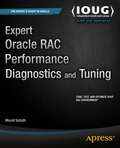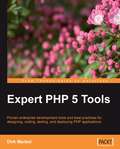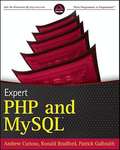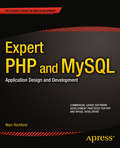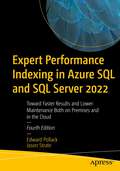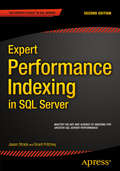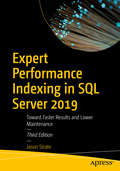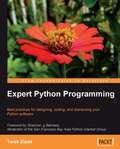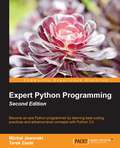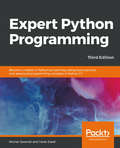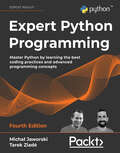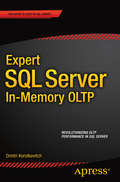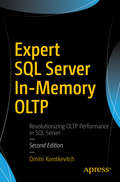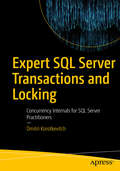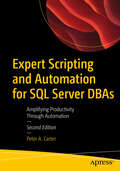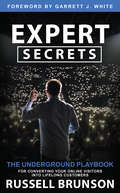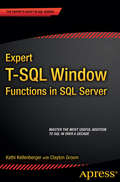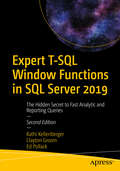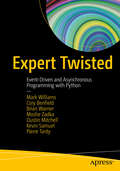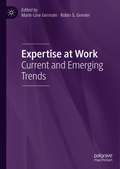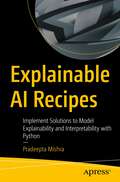- Table View
- List View
Expert Oracle RAC Performance Diagnostics and Tuning
by Murali VallathExpert Oracle RAC Performance Diagnostics and Tuning provides comprehensive coverage of the features, technology and principles for testing and tuning RAC databases. The book takes a deep look at optimizing RAC databases by following a methodical approach based on scientific analysis rather than using a speculative approach, twisting and turning knobs and gambling on the system. The book starts with the basic concepts of tuning methodology, capacity planning, and architecture. Author Murali Vallath then dissects the various tiers of the testing implementation, including the operating system, the network, the application, the storage, the instance, the database, and the grid infrastructure. He also introduces tools for performance optimization and thoroughly covers each aspect of the tuning process, using many real-world examples, analyses, and solutions from the field that provide you with a solid, practical, and replicable approach to tuning a RAC environment. The book concludes with troubleshooting guidance and quick reference of all the scripts used in the book. Expert Oracle RAC Performance Diagnostics and Tuning covers scenarios and details never discussed before in any other performance tuning books. If you have a RAC database, this book is a requirement. Get your copy today. Takes you through optimizing the various tiers of the RAC environment. Provides real life case studies, analysis and solutions from the field. Maps a methodical approach to testing, tuning and diagnosing the cluster What you'll learn Dissect the eight stage pre-implementation testing process across all tiers of the RAC cluster Optimize your RAC cluster for availability and scalability Diagnose your cluster to get the root of any performance problem Establish a replicable methodology for testing, tuning, and diagnostics Walk through real-world examples and solutions. Learn how to be proactive to prevent common performance issues Discover an exhaustive list of tools to help optimize your RAC environment Who this book is for Expert Oracle RAC Performance Diagnostics and Tuning is for all those customers implementing RAC systems into a production environment without undergoing a systematic methodology for testing, tuning and problem solving. Table of Contents 1. Methodology 2. Capacity Planning and Architecture 3. Testing for Availability 4. Testing for Scalability 5. Real Application Testing 6. Tools and Utilities 7. SQL Tuning 8. Parallel Query Tuning 9. Tuning the Database 10. Tuning Recovery 11. Tuning Oracle Net 12. Tuning Storage Subsystem 13. Tuning Global Cache 14. Tuning the Cluster Interconnect 15. Optimization of Distributed Workload 16. Tuning the Oracle Clusterware 17. Enqueues, Waits and Latches 18. Problem Diagnostics A. The SQL Scripts Used in This Book Bibliography
Expert PHP 5 Tools
by Dirk MerkelEach chapter focuses on one topic, such as version control or debugging. After initially discussing essential concepts, the author takes an in-depth look at one or more tools relevant to the topic. Sample projects and plenty of well-documented code are used to work through practical application of the concepts. This book has been written for professional developers new to PHP and experienced PHP developers who want to take their skills to the next level by learning enterprise-level tools and techniques.
Expert PHP and MySQL
by Andrew Curioso Ronald Bradford Patrick GalbraithBest practices and expert techniques for even the most demanding MySQL-driven PHP applications PHP is the world's most popular, general-purpose, open-source scripting language and MySQL is the world's most popular open-source database. This expert-level book begins with a brief overview of the two technologies and quickly moves on to coverage of advanced programming techniques, as well as the exciting new features of the PHP 5. 3 release. Written by three of PHP and MySQL experts and veteran authors, this resource focuses on best practices and expert techniques that can be applied to the most difficult MySQL-driven PHP applications. The authors share design patterns and tools that they themselves have tested in order to save you valuable time usually spent on figuring things out via trial and error. Reveals best practices and advanced techniques for handling challenges you may face with MySQL-driven PHP apps Reviews practical data reporting techniques for separating business logic from presentation Explains how to obtain improved performance and flexibility through caching, multi-tasking, PHP extensions, and MySQL user defined functions Discusses security, optimization, and debugging Shares author-tested design patterns and tools to save you time and effort Packed with helpful examples and indispensable advice, this book shares tips and tricks that you can immediately apply to your projects. Note: CD-ROM/DVD and other supplementary materials are not included as part of eBook file.
Expert PHP and MySQL
by Marc RochkindExpert PHP and MySQL takes you beyond learning syntax to showing you how to apply proven software development methods to building commerce-grade PHP and MySQL projects that will stand the test of time and reliably deliver on customer needs. Developers of real-world applications face numerous problems that seem trivial on the surface, but really do take some skill to get right. Error handling is about more than just the mechanics in the PHP syntax, but also about handling MySQL errors, logging those errors, and about hiding information about application internals that error messages sometimes can expose. Meet these challenges and more head-on! Author Marc Rochkind shows how to begin a project right, with a clear contract and set of written requirements. You'll learn about project organization, setting up a solid development environment, connecting with client personnel. Database design is essential, and Expert PHP and MySQL has you covered with guidance on creating a sound model and database, and on pushing functionality into the database as appropriate; not everything should be done in PHP. Error handling is covered at both the PHP and MySQL levels. Application structure is covered. Guidance is provided on reporting. And finally there is conversion. In Expert PHP and MySQL you'll explore the following: The popular and widely used combination of PHP and MySQL Commercial-grade application of language and database features Human factors such as planning and organization Organizing a project to meet requirements and satisfy the customer Structuring an application for efficient development and future modification Coding PHP for productivity, reliability, security Generating online, downloadable, and printed reports Converting existing data to the new application What you'll learn Organize a project to meet requirements and satisfy the customer. Structure an application for efficient development and future modification. Design a database to model the business and support the application. Code PHP for productivity, reliability, security. Generate online, downloadable, and printed reports. Convert existing data to the new application. Who this book is for Expert PHP and MySQL is aimed at programmers competent in PHP and MySQL. Readers should know the mechanics of the language and the database, and have a desire to learn to build commercial systems that will stand the test of time and reliably deliver on customer needs. Table of Contents Project Organization Requirements Platforms and Tools The Database Application Structure Security, Forms, and Error Handling Reports and Other Outputs Data Conversion
Expert Performance Indexing in Azure SQL and SQL Server 2022: Toward Faster Results and Lower Maintenance Both on Premises and in the Cloud
by Edward Pollack Jason StrateTake a deep dive into perhaps the single most important facet of query performance—indexes—and how to best use them. Newly updated for SQL Server 2022 and Azure SQL, this fourth edition includes new guidance and features related to columnstore indexes, improved and consolidated content on Query Store, deeper content around Intelligent Query Processing, and other updates to help you optimize query execution and make performance improvements to even the most challenging workloads. The book begins with explanations of the types of indexes and how they are stored in a database. Moving further into the book, you will learn how statistics are critical for optimal index usage and how the Index Advisor can assist in reviewing and optimizing index health. This book helps you build a clear understanding of how indexes work, how to implement and use them, and the many options available to tame even the most large and complex workloads.What You Will LearnProperly index row store, columnstore, and memory-optimized tablesMake use of Intelligent Query Processing for faster query resultsReview statistics to understand indexing choices made by the optimizerApply indexing strategies such as covering indexes, included columns, and index intersectionsRecognize and remove unnecessary indexesDesign effective indexes for full-text, spatial, and XML data typesWho This Book Is ForAzure SQL and SQL Server administrators and developers who are ready to improve the performance of their database environment by thoughtfully building indexes to speed up queries that matter the most and make a difference to the business
Expert Performance Indexing in SQL Server
by Jason Strate Grant FritcheyThis book is a deep dive into perhaps the single-most important facet of good performance: indexes, and how to best use them. The book begins in the shallow waters with explanations of the types of indexes and how they are stored in databases. Moving deeper into the topic, and further into the book, you will look at the statistics that are accumulated both by indexes and on indexes. You'll better understand what indexes are doing in the database and what can be done to mitigate and improve their effect on performance. The final destination is a guided tour through a number of real life scenarios showing approaches you can take to investigate, mitigate, and improve the performance of your database. Defines the types of indexes and their implementation options Provides use cases and common patterns in applying indexing Describes and explain the index metadata and statistics Provides a framework of strategies and approaches for indexing databases What you'll learn Properly index in-memory OLTP tables Recognize and remove unnecessary indexes Review statistics to understand indexing choices made by the optimizer Properly apply strategies such as covering indexes, included columns, index intersections, and more Write queries to make good use of the indexes already in place Design effective indexes for full-text, spatial, and XML data types Manage the big picture: Encompassing all indexes in a database, and all database instances on a server Who this book is for Expert Performance Indexing in SQL Server is intended for database administrators and developers who are ready to lift the performance of their environment by thoughtfully building indexes to speed up the queries that matter the most and make a difference to the business. Table of Contents Introduction 1. Index Fundamentals 2. Index Storage Fundamentals 3. Index Metadata and Statistics 4. XML Indexes 5. Spatial Indexes 6. Full-text Indexes and Semantic Search 7. Indexing Memory-Optimized Tables 8. Index Myths and Best Practices 9. Index Maintenance 10. Indexing Tools 11. Indexing Strategies 12. Query Strategies 13. Monitoring Your Indexes 14. Index Analysis 15. Indexing Methodology
Expert Performance Indexing in SQL Server 2019: Toward Faster Results and Lower Maintenance
by Jason StrateTake a deep dive into perhaps the single most important facet of good performance: indexes, and how to best use them. Recent updates to SQL Server have made it possible to create indexes in situations that in the past would have prevented their use.Other improvements covered in this book include new dynamic management views, the ability to pause and resume index maintenance, and the ability to more easily recover from failures during index creation and maintenance operations. This new edition also brings new content around the indexing of columnstore and in-memory tables, showing how these new types of tables and the queries that execute against them can also benefit from good indexing practices. The book begins with explanations of the types of indexes and how they are stored in databases. Moving deeper into the topic, and further into the book, you will look at the statistics that are accumulated both by indexes and on indexes. You will better understand what indexes are doing in the database and what can be done to mitigate and improve their effect on performance. You will get a look at the Index Advisor now available in Azure SQL Database, and learn how to review and maintain the health of your indexes. The final chapters present a guided tour through a number of scenarios showing approaches you can take to investigate, mitigate, and improve the performance of your database.What You Will LearnProperly index row store, columnstore, and in-memory tablesReview statistics to understand indexing choices made by the optimizerApply indexing strategies such as covering indexes, included columns, and index intersectionsRecognize and remove unnecessary indexesDesign effective indexes for full-text, spatial, and XML data typesManage the big picture: Encompass all indexes in a database, and all database instances on a serverWho This Book Is ForDatabase administrators and developers who are ready to lift the performance of their database environment by thoughtfully building indexes to speed up queries that matter the most and make a difference to the business
Expert Python Programming
by Tarek ZiadeThis book is an authoritative exploration of Python best practices and applications of agile methodologies to Python, illustrated with practical, real-world examples. This book is for Python developers who are already building applications, but want to build better ones by applying best practices and new development techniques to their projects. The reader is expected to have a sound background in Python programming.
Expert Python Programming - Second Edition
by Tarek Ziade Michal JaworskiBecome an ace Python programmer by learning best coding practices and advance-level concepts with Python 3.5 About This Book * Based on the latest stable version of Python (version 3.5) * Creating well manageable code that will run in various environments with different sets of dependencies * Packed with advanced concepts and best practices to write efficient Python code Who This Book Is For The book would appeal to web developers and Python programmers who want to start using version 3.5 and write code efficiently. Basic knowledge of Python programming is expected. What You Will Learn * Conventions and best practices that are widely adopted in the python community * Package python code effectively for community and production use * Easy and lightweight ways to automate code deployment on remote systems * Improve your code's quality, reliability, and performance * Write concurrent code in python * Extend python with code written in different languages In Detail Python is a dynamic programming language, used in a wide range of domains by programmers who find it simple, yet powerful. Even if you find writing Python code easy, writing code that is efficient and easy to maintain and reuse is a challenge. The focus of the book is to familiarize you with common conventions, best practices, useful tools and standards used by python professionals on a daily basis when working with code. You will begin with knowing new features in Python 3.5 and quick tricks for improving productivity. Next, you will learn advanced and useful python syntax elements brought to this new version. Using advanced object-oriented concepts and mechanisms available in python, you will learn different approaches to implement metaprogramming. You will learn to choose good names, write packages, and create standalone executables easily. You will also be using some powerful tools such as buildout and vitualenv to release and deploy the code on remote servers for production use. Moving on, you will learn to effectively create Python extensions with C, C++, cython, and pyrex. The important factors while writing code such as code management tools, writing clear documentation, and test-driven development are also covered. You will now dive deeper to make your code efficient with general rules of optimization, strategies for finding bottlenecks, and selected tools for application optimization. By the end of the book, you will be an expert in writing efficient and maintainable code. Style and approach An easy-to-follow guide that covers industry followed best practices in Python programming
Expert Python Programming,: Become a master in Python by learning coding best practices and advanced programming concepts in Python 3.7, 3rd Edition
by Michał Jaworski Tarek ZiadéRefine your Python programming skills and build professional grade applications with this comprehensive guideKey FeaturesCreate manageable code that can run in various environments with different sets of dependenciesImplement effective Python data structures and algorithms to write optimized codeDiscover the exciting new features of Python 3.7Book DescriptionPython is a dynamic programming language that's used in a wide range of domains thanks to its simple yet powerful nature. Although writing Python code is easy, making it readable, reusable, and easy to maintain is challenging. Complete with best practices, useful tools, and standards implemented by professional Python developers, the third edition of Expert Python Programming will help you overcome this challenge.The book will start by taking you through the new features in Python 3.7. You'll then learn the advanced components of Python syntax, in addition to understanding how to apply concepts of various programming paradigms, including object-oriented programming, functional programming, and event-driven programming. This book will also guide you through learning the best naming practices, writing your own distributable Python packages, and getting up to speed with automated ways of deploying your software on remote servers. You’ll discover how to create useful Python extensions with C, C++, Cython, and CFFI. Furthermore, studying about code management tools, writing clear documentation, and exploring test-driven development will help you write clean code.By the end of the book, you will have become an expert in writing efficient and maintainable Python code.What you will learnExplore modern ways of setting up repeatable and consistent development environmentsPackage Python code effectively for community and production useLearn modern syntax elements of Python programming such as f-strings, enums, and lambda functionsDemystify metaprogramming in Python with metaclassesWrite concurrent code in PythonExtend Python with code written in different languagesIntegrate Python with code written in different languagesWho this book is forThis book will appeal to you if you’re a programmer looking to take your Python knowledge to the next level by writing efficient code and learning the latest features of version 3.7 and above.
Expert Python Programming: Master Python by learning the best coding practices and advanced programming concepts, 4th Edition
by Tarek Ziade Michal JaworskiAttain a deep understanding of building, maintaining, packaging, and shipping robust Python applicationsKey FeaturesDiscover the new features of Python, such as dictionary merge, the zoneinfo module, and structural pattern matchingCreate manageable code to run in various environments with different sets of dependenciesImplement effective Python data structures and algorithms to write, test, and optimize codeBook DescriptionPython is used in a wide range of domains owing to its simple yet powerful nature. Although writing Python code is easy, making it readable, reusable, and easy to maintain can be challenging. Complete with best practices, useful tools, and standards implemented by professional Python developers, this fourth edition will help you in not only overcoming such challenges but also learning Python's latest features and advanced concepts. The book begins with a warm-up, where you will catch-up with the latest Python improvements, syntax elements, and interesting tools to boost your development efficiency. Further, the initial few chapters should allow experienced programmers coming from different languages to safely land in the Python ecosystem. As you progress, you will explore common software design patterns and various programming methodologies, such as event-driven programming, concurrency, and metaprogramming. You will also go through complex code examples and try to solve meaningful problems by bridging Python with C and C++, writing extensions that benefit from the strengths of multiple languages. Finally, you will understand the complete lifetime of any application after it goes live. By the end of the book, you should be proficient in writing efficient and maintainable Python code.What you will learnExplore modern ways of setting up repeatable and consistent Python development environmentsEffectively package Python code for community and production useLearn about modern syntax elements of Python programming, such as f-strings, dataclasses, enums, and lambda functionsDemystify metaprogramming in Python with metaclassesWrite concurrent code in PythonMonitor and optimize the performance of Python applicationExtend and integrate Python with code written in different languagesWho this book is forThe Python programming book is intended for expert programmers who want to learn Python's advanced-level concepts and latest features.Anyone who has basic Python skills should be able to follow the content of the book, although it might require some additional effort from less experienced programmers. It should also be a good introduction to Python 3.9 for those who are still a bit behind and continue to use other older versions.
Expert SQL Server In-Memory OLTP
by Dmitri KorotkevitchExpert SQL Server In-Memory OLTP is a deep dive into one of the most significant features of SQL Server 2014 - support for In-Memory Online Transaction Processing. The book describes the architecture and internals of the In-Memory OLTP Engine and explains how to develop, deploy, and maintain systems using it. With it you can dramatically increase transactional throughput to handle thousands of transactions per second supporting millions of customers. Dmitri Korotkevitch is the five-star author of Pro SQL Server Internals, and now brings his same combination of clear thinking and deep expertise to the question of how to recognize the opportunities and benefit from Microsoft's In-Memory OLTP feature set in SQL Server 2014. Learn the architecture and the internals in order to recognize when in-memory OLTP can make a difference. Learn useful scenarios for thoughtfully incorporating In-Memory support into existing applications. Recognize opportunities for In-Memory OLTP in new development. Don't be without Dmitri Korotkevitch and the deep expertise he imparts in Expert SQL Server In-Memory OLTP as you move forward in using SQL Server's new and important In-Memory OLTP feature set. Covers In-Memory OLTP internals and architecture, including data storage, indexing, multi-version concurrency control, transaction logging, and recovery Illustrates In-Memory OLTP programmability and the process of native compilation Guides in using In-Memory OLTP in new development and existing systems. What you'll learn Grasp the internal mechanisms underlying in-memory tables and their implementation Plan successful implementations, including the required memory size and I/O configuration Properly index in-memory tables, including with hash indexes and range indexes Accelerate T-SQL processing through the creation of natively-compiled stored procedures Control disk I/O by managing logging, checkpoint, and recovery of in-memory data Monitor and report on the benefits and performance of your in-memory solutions Who this book is for Expert SQL Server In-Memory OLTP is for application developers and database administrators who create and manage online transaction processing (OLTP) systems. In particular, the book is aimed at those wanting to take advantage of SQL Server's new offering of in-memory OLTP to dramatically improve performance and throughput of their systems. Table of Contents Introduction 1. Why In-Memory OLTP? 2. In-Memory OLTP Objects 3. Memory-Optimized Tables 4. Hash Indexes 5. Nonclustered Indexes 6. In-Memory OLTP Prgrammability 7. In-Memory OLTP Concurrency Model 8. Data Storage, Logging, and Recovery 9. Garbage Collection 10. Deployment and Management 11. Utilizing In-Memory OLTP 12. Appendix A: Memory Pointer Management 13. Appendix B: Page Splitting and Merging in Nonclustered Indexes 14. Appendix C: Analyzing Checkpoint File Pair State 15. Appendix D: In-Memory OLTP Migration Tools
Expert SQL Server In-Memory OLTP
by Dmitri KorotkevitchExpert SQL Server In-Memory OLTP is a deep dive into one of the most significant features of SQL Server 2014 - support for In-Memory Online Transaction Processing. The book describes the architecture and internals of the In-Memory OLTP Engine and explains how to develop, deploy, and maintain systems using it. With it you can dramatically increase transactional throughput to handle thousands of transactions per second supporting millions of customers. Dmitri Korotkevitch is the five-star author of Pro SQL Server Internals, and now brings his same combination of clear thinking and deep expertise to the question of how to recognize the opportunities and benefit from Microsoft's In-Memory OLTP feature set in SQL Server 2014. Learn the architecture and the internals in order to recognize when In-Memory OLTP can make a difference. Learn useful scenarios for thoughtfully incorporating in-memory support into existing applications. Recognize opportunities for In-Memory OLTP in new development. Don't be without Dmitri Korotkevitch and the deep expertise he imparts in Expert SQL Server In-Memory OLTP as you move forward in using SQL Server's new and important In-Memory OLTP feature set. Covers In-Memory OLTP internals and architecture, including data storage, indexing, multi-version concurrency control, transaction logging, and recovery Illustrates In-Memory OLTP programmability and the process of native compilation Guides in using In-Memory OLTP in new development and existing systems.
Expert SQL Server Transactions and Locking: Concurrency Internals for SQL Server Practitioners
by Dmitri KorotkevitchMaster SQL Server’s Concurrency Model so you can implement high-throughput systems that deliver transactional consistency to your application customers. This book explains how to troubleshoot and address blocking problems and deadlocks, and write code and design database schemas to minimize concurrency issues in the systems you develop.SQL Server’s Concurrency Model is one of the least understood parts of the SQL Server Database Engine. Almost every SQL Server system experiences hard-to-explain concurrency and blocking issues, and it can be extremely confusing to solve those issues without a base of knowledge in the internals of the Engine. While confusing from the outside, the SQL Server Concurrency Model is based on several well-defined principles that are covered in this book.Understanding the internals surrounding SQL Server’s Concurrency Model helps you build high-throughput systems in multi-user environments. This book guides you through the Concurrency Model and elaborates how SQL Server supports transactional consistency in the databases. The book covers all versions of SQL Server, including Microsoft Azure SQL Database, and it includes coverage of new technologies such as In-Memory OLTP and Columnstore Indexes.What You'll LearnKnow how transaction isolation levels affect locking behavior and concurrencyTroubleshoot and address blocking issues and deadlocksProvide required data consistency while minimizing concurrency issuesDesign efficient transaction strategies that lead to scalable codeReduce concurrency problems through good schema designUnderstand concurrency models for In-Memory OLTP and Columnstore IndexesReduce blocking during index maintenance, batch data load, and similar tasksWho This Book Is ForSQL Server developers, database administrators, and application architects who are developing highly-concurrent applications. The book is for anyone interested in the technical aspects of creating and troubleshooting high-throughput systems that respond swiftly to user requests.
Expert Scripting and Automation for SQL Server DBAs: Amplifying Productivity Through Automation
by Peter A. CarterThe market is trending toward a much smaller ratio of DBAs to SQL Server instances, but this book will help you meet this new reality by harnessing automation to continue building and maintaining reliable database platform services for your SQL Server enterprise. The book will help you automate your workload and manage more databases and instances with greater ease and efficiency by combining metadata-driven automation with the power of PowerShell. You'll soon be able to automate your new instance-builds and centralize your maintenance. This book walks you through automating the SQL Server build processes and maintenance of multiple instances from a single location, as well as how to use database metadata to drive your automation. With a heavier focus on PowerShell, this 2nd edition highlights modern techniques, such as configuration management. Also new in this edition, you will learn how to use PowerShell modules such as SqlServer and DBATools, which is a popular community module that you can rely on to keep your database estate running smoothly. You will understand the benefits of centralizing maintenance to better keep your enterprise responding with reliable performance to the loads placed upon it by your business. The book helps you become faster and better at what you do for a living, and thus will boost your value within the job market. What You Will Learn Automate SQL Server installation and configuration Apply techniques such as Desired State Configuration to prevent drift on your servers and instances Increase your value to your organization by automating low-value tasks and focusing your time on the higher-value ones Take advantage of database metadata to drive automation, allowing you to build intelligent automated routines Promote and demonstrate how to modernize database maintenance across your enterprise Apply tools such as PowerShell with modern techniques to increase your value in the job market Who This Book Is For SQL Server DBAs who want to increase their productivity by embracing automation
Expert Secrets: The Underground Playbook for Converting Your Online Visitors into Lifelong Customers
by Russell BrunsonMaster the art of what to say in your funnels to convert your online visitors into lifelong customers in this updated edition from the $100M entrepreneur and co-founder of the software company ClickFunnels.Your business is a calling. You've been called to serve a group of people with the products, services, and offers that you've created. The impact that the right message can have on someone at the right time in their life is immeasurable. Your message could help to save marriages, repair families, change someone's health, grow a company, or more. . . . But only if you know how to get it into the hands of the people whose lives you have been called to change.By positioning yourself as an expert and telling your story in a way that gets people to move, you will be able to guide people through your value ladder, offer solutions to their problems, and give them the results they are looking for. This is how you change the lives of your customers, and this is how you grow your company.In this updated edition of Expert Secrets, Russell Brunson, CEO and co-founder of the multimillion-dollar software company ClickFunnels, gives you the step-by-step strategies you need to turn your expertise into a carefully crafted sales message that will attract your dream customers.Don't hide inside your business. Implement these story selling techniques now so you can find your voice and gain the confidence to become a leader, build a movement of people whose lives you can change, and make this calling a career.
Expert Sniper Strategies for Fortniters: An Unofficial Guide to Battle Royale (Master Combat)
by Jason RichHit your target every time with this Fortnite expert sniper guide. This all‑new, unofficial, illustrated guide series will turn you into a master Fortnite: Battle Royale gamer by uncovering all the best strategies and secrets of this wildly popular game. Whether you play Fortnite Battle Royale on a PC, Mac, Xbox One, PlayStation 4, or your mobile device, you’ll find everything you need to stay at the top of your game. Each book is packed with useful insider tips on topics like, staying alive longer, exploring, collecting a powerful arsenal, building, and snagging more victories during each match. When it comes to achieving #1 Victory Royale, the Fortnite Battle Royale: Master Combat Series provides the ultimate competitive edge. Thanks to this comprehensive how‑to Fortnite shooting guide, you’ll gain the crucial battle skills you need to eliminate your enemies like a pro. Sniper rifles and projectile weapons are only as good as the player using them. This comprehensive resource will sharpen your skills and show you how and when to use the incredible range of guns, weapons, tools, and ammunition available during each match. There’s nothing more important in Fortnite than staying alive longer and battling your way to #1 Victory Royale. This straightforward guide has everything you need to prepare for long‑range, mid‑range, and close‑range combat situations so that you can emerge a winner.
Expert Systems in Chemistry Research
by Markus C. HemmerExpert systems allow scientists to access, manage, and apply data and specialized knowledge from various disciplines to their own research. Expert Systems in Chemistry Research explains the general scientific basis and computational principles behind expert systems and demonstrates how they can improve the efficiency of scientific workflows
Expert T-SQL Window Functions in SQL Server
by Kathi Kellenberger Clayton GroomExpert T-SQL Window Functions in SQL Server takes you from any level of knowledge of windowing functions and turns you into an expert who can use these powerful functions to solve many T-SQL queries. Replace slow cursors and self-joins with queries that are easy to write and fantastically better performing, all through the magic of window functions. First introduced in SQL Server 2005, window functions came into full blossom with SQL Server 2012. They truly are one of the most notable developments in SQL in a decade, and every developer and DBA can benefit from their expressive power in solving day-to-day business problems. Begin using windowing functions like ROW_NUMBER and LAG, and you will discover more ways to use them every day. You will approach SQL Server queries in a different way, thinking about sets of data instead of individual rows. Your queries will run faster, they will be easier to write, and they will be easier to deconstruct and maintain and enhance in the future. Just knowing and using these functions is not enough. You also need to understand how to tune the queries. Expert T-SQL Window Functions in SQL Server explains clearly how to get the best performance. The book also covers the rare cases when older techniques are the best bet. Stop using cursors and self-joins to solve complicated queries. Become a T-SQL expert by mastering windowing functions. Teaches you how to use all the window functions introduced in 2005 and 2012. Provides real-world examples that you can experiment with in your own database. Explains how to get the best performance when using windowing functions. What you'll learn Create aggregations by defining sets of rows with the OVER clause. Calculate aggregates without losing the details. Rank and bucketize data for reporting purposes. Reduce and often eliminate self-joins. Reduce and often eliminate row-by-row cursor processing. Write simpler queries that perform with greater speed. Recognize situations when window functions make a difference. Who this book is for Expert T-SQL Window Functions in SQL Server is for the SQL Server database professionals who are ready to take on the biggest leap in query-writing expressiveness and performance to hit the SQL language in years. It's for developers and database administrators who may have heard about windowing functions, but who haven't had a chance to learn much about them. Expert T-SQL Window Functions in SQL Server is an excellent way for database professionals to get up to speed on these functions and put their benefits to work. Table of Contents 1. Looking through the Window 2. Discovering Ranking Functions 3. Aggregating with Window Functions 4. Tuning for Better Performance 5. Calculating Rolling and Running Aggregates 6. Adding Frames to the Window 7. Peaking at Other Rows 8. Understanding Statistical Functions 9. The Future of Window Functions
Expert T-SQL Window Functions in SQL Server 2019: The Hidden Secret to Fast Analytic and Reporting Queries
by Kathi Kellenberger Clayton Groom Ed PollackBecome an expert who can use window functions to solve T-SQL query problems. Replace slow cursors and self-joins with queries that are easy to write and perform better. This new edition provides expanded examples, including a chapter from the world of sports, and covers the latest performance enhancements through SQL Server 2019. Window functions are useful in analytics and business intelligence reporting. They came into full blossom with SQL Server 2012, yet they are not as well known and used as often as they ought to be. This group of functions is one of the most notable developments in SQL, and this book shows how every developer and DBA can benefit from their expressive power in solving day-to-day business problems. Once you begin using window functions, such as ROW_NUMBER and LAG, you will discover many ways to use them. You will approach SQL Server queries in a different way, thinking about sets of data instead of individual rows. Your queries will run faster, be easier to write, and easier to deconstruct, maintain, and enhance in the future.Just knowing and using these functions is not enough. You also need to understand how to tune the queries. Expert T-SQL Window Functions in SQL Server clearly explains how to get the best performance. The book also covers the rare cases when older techniques are the best bet.What You Will LearnSolve complex query problems without cumbersome self-joins that run slowly and are difficult to readCreate sliding windows in a result set for computing such as running totals and moving averagesReturn aggregate and detail data simultaneously from the same SELECT statementCompute lag and lead and other values that access data from multiple rows in a result setUnderstand the OVER clause syntax and how to control the windowAvoid framing errors that can lead to unexpected resultsWho This Book Is For Anyone who writes T-SQL queries, including database administrators, developers, business analysts, and data scientists. Before reading this book, you should understand how to join tables, write WHERE clauses, and build aggregate queries.
Expert Twisted: Event-driven And Asynchronous Programming With Python
by Mark Williams Cory Benfield Brian Warner Moshe Zadka Dustin Mitchell Kevin Samuel Pierre TardyExplore Twisted, the Python-based event-driven networking engine, and review several of its most popular application projects. It is written by community leaders who have contributed to many of the projects covered, and share their hard-won insights and experience.Expert Twisted starts with an introduction to event-driven programming, explaining it in the context of what makes Twisted unique. It shows how Twisted's design emphasizes testability as a solution to common challenges of reliability, debugging, and start-to-finish causality that are inherent in event-driven programming. It also explains asynchronous programming, and the importance of functions, deferreds, and coroutines. It then uses two popular applications, treq and klein, to demonstrate calling and writing Web APIs with Twisted.The second part of the book dives into Twisted projects, in each case explaining how the project fits into the Twisted ecosystem and what it does, and offers several examples to bring readers up to speed, with pointers to additional resources for more depth. Examples include using Twisted with Docker, as a WSGI container, for file sharing, and more.What You'll LearnIntegrate Twisted and asyncio using adaptersAutomate software build, test, and release processes with BuildbotCreate clients and servers with AutobahnTransfer files with Magic WormholeDistribute cloud-based file storage with Tahoe LAFSUnderstand HTTP/2 with Python and TwistedSupport for asynchronous tasks using Django ChannelsWho This Book Is ForReaders should have some Python experience and understand the essentials of containers and protocols, but need not be familiar with Twisted or the associated projects covered in the book.
Expertise at Work: Current and Emerging Trends
by Marie-Line Germain Robin S. GrenierExpertise, which combines knowledge, years of experience in one domain, problem-solving skills, and behavioral traits, is a valuable resource for organizations. To understand the diverse picture of expertise in the workplace, this book offers scholars and scholar-practitioners a comprehensive assessment of the development of human expertise in organizations. Using contemporary perspectives across a broad range of domains, contributors offer readers various professional perspectives including veterans, education, sports, and information technology. The book also describes how researchers and practitioners can address practical problems related to the development, redevelopment, and sustainability of expertise. Finally, the book puts specific emphasis on the emerging trends in the study and practice of expertise in organizations, including the use of artificial intelligence.
Explainable AI (XAI) for Sustainable Development: Trends and Applications
by Seifedine Kadry Rajesh Kumar Dhanaraj Ravi Shekhar Tiwari Lakshmi D.This book presents innovative research works to automate, innovate, design, and deploy AI fo real-world applications. It discusses AI applications in major cutting-edge technologies and details about deployment solutions for different applications for sustainable development. The application of Blockchain techniques illustrates the ways of optimisation algorithms in this book. The challenges associated with AI deployment are also discussed in detail, and edge computing with machine learning solutions is explained. This book provides multi-domain applications of AI to the readers to help find innovative methods towards the business, sustainability, and customer outreach paradigms in the AI domain.• Focuses on virtual machine placement and migration techniques for cloud data centres• Presents the role of machine learning and meta-heuristic approaches for optimisation in cloud computing services• Includes application of placement techniques for quality of service, performance, and reliability improvement• Explores data centre resource management, load balancing and orchestration using machine learning techniques• Analyses dynamic and scalable resource scheduling with a focus on resource managementThe reference work is for postgraduate students, professionals, and academic researchers in computer science and information technology.
Explainable AI Recipes: Implement Solutions to Model Explainability and Interpretability with Python
by Pradeepta MishraUnderstand how to use Explainable AI (XAI) libraries and build trust in AI and machine learning models. This book utilizes a problem-solution approach to explaining machine learning models and their algorithms. The book starts with model interpretation for supervised learning linear models, which includes feature importance, partial dependency analysis, and influential data point analysis for both classification and regression models. Next, it explains supervised learning using non-linear models and state-of-the-art frameworks such as SHAP values/scores and LIME for local interpretation. Explainability for time series models is covered using LIME and SHAP, as are natural language processing-related tasks such as text classification, and sentiment analysis with ELI5, and ALIBI. The book concludes with complex model classification and regression-like neural networks and deep learning models using the CAPTUM framework that shows feature attribution, neuron attribution, and activation attribution. After reading this book, you will understand AI and machine learning models and be able to put that knowledge into practice to bring more accuracy and transparency to your analyses.What You Will LearnCreate code snippets and explain machine learning models using PythonLeverage deep learning models using the latest code with agile implementationsBuild, train, and explain neural network models designed to scaleUnderstand the different variants of neural network models Who This Book Is ForAI engineers, data scientists, and software developers interested in XAI
Explainable AI Within the Digital Transformation and Cyber Physical Systems: XAI Methods and Applications
by Moamar Sayed-MouchawehThis book presents Explainable Artificial Intelligence (XAI), which aims at producing explainable models that enable human users to understand and appropriately trust the obtained results. The authors discuss the challenges involved in making machine learning-based AI explainable. Firstly, that the explanations must be adapted to different stakeholders (end-users, policy makers, industries, utilities etc.) with different levels of technical knowledge (managers, engineers, technicians, etc.) in different application domains. Secondly, that it is important to develop an evaluation framework and standards in order to measure the effectiveness of the provided explanations at the human and the technical levels. This book gathers research contributions aiming at the development and/or the use of XAI techniques in order to address the aforementioned challenges in different applications such as healthcare, finance, cybersecurity, and document summarization. It allows highlighting the benefits and requirements of using explainable models in different application domains in order to provide guidance to readers to select the most adapted models to their specified problem and conditions.Includes recent developments of the use of Explainable Artificial Intelligence (XAI) in order to address the challenges of digital transition and cyber-physical systems;Provides a textual scientific description of the use of XAI in order to address the challenges of digital transition and cyber-physical systems;Presents examples and case studies in order to increase transparency and understanding of the methodological concepts.
